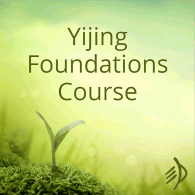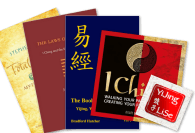![]() Hexagram 20 is called Seeing – but if your I Ching experience began with Wilhelm, then you’ll be familiar with the idea that the shape of the hexagram itself is a picture of an ancient tower:
Hexagram 20 is called Seeing – but if your I Ching experience began with Wilhelm, then you’ll be familiar with the idea that the shape of the hexagram itself is a picture of an ancient tower:
‘A tower of this kind commanded a wide view of the country; at the same time, when situated on a mountain, it became a landmark that could be seen for miles around.’
Wilhelm mentions a ‘variation in tonal stress’ that gives the hexagram name, guan 觀, a double meaning, and seems to imply that this double meaning is both ‘seeing’ and ‘being seen’. But guan means both ‘seeing’ and – in a different tone – ‘tower‘.
Scott Davis agrees about the hexagram shape –
‘The hexagram shows a raised architectural structure with four broken lines beneath, indicating the tower’s balanced support, two yang lines on top indicating the elevated platform from which one views surroundings from a height.’
– and goes so far as to refer to the hexagram as ‘Tower’. (This wouldn’t work so well in a translation – see the moving lines. ‘Tower my life, advancing-withdrawing’?)
The principal use of such a tower would be to observe the heavens and align human activity with its rhythms. Observatories were built for this purpose in China as early as 2000BC, and Waley thought 20.4, ‘Seeing the glories of the realm,’ might mean observing heavenly portents.
I came across a story of the building of guan towers in Han times, in Picturing Heaven in Early China by Lillian Lan-ying Tseng. Emperor Wu of the Han went to great lengths to meet immortals to learn their secret, without success. His advisor told him that instead of chasing after immortals, he should draw them to him – by building towers that would attract them. And so, in 110BC, Wu had built the guan of Wind and Cinnamon and the guan of Longevity.
Of course this is all from long after the Yi was written – and as far as I know, Zhou rulers weren’t so fixated on immortals and immortality. But isn’t it interesting, this underlying idea that you would construct a tower to attract spirits? To me, Hexagram 20 seems to begin with the power of unclouded attention to draw the spirits closer. ‘Washing hands and not making the offering’ is a way of ‘constructing’ that quality of attention – creating a space with a drawing, magnetic power. The yin lines are open to receive; the yang lines are pulling what they observe into that space.
As for how guan towers were constructed, Tseng says,
‘The mural in an Eastern Han tomb at Anping, Hebei, depicts a sky-scraping watchtower standing in a walled city. The watchtower is a wide-open, one-story wooden structure on an earthen terrace. The watchtower apparently gains its soaring height from the earthen terrace, not from the wooden structure itself. The structure could be a guan tower on an earthen base or a tai terrace with a wooden shelter.’
As she explains it, the technology may not have existed to build a very tall wooden building, and so the height of an observation tower had to come from its pounded earth mound. The mound for the Temple of Longevity is still 6 metres high.
We can surely assume that Zhou guan towers would be constructed the same way: wood over earth, just like the component trigrams of Hexagram 20.











Harmen wrote about 觀/guan almost eleven years ago. Those are the kind of things that I remember when prompted by other friend’s posts…
http://www.yjcn.nl/wp/191/
Beautiful. I love the way this entry clicks shut, like a box, on the component trigrams being the materials for a tower. Reminds me of Ezra Pound’s meditations on the Chinese written characters, and the visual poetry he saw in them.
Thanks, Luis! It’ll be interesting to see what Harmen makes of 20 when he reaches it in his ‘translation notes’ series.
Hello, Brian – and thank you – and thanks also for the link to your app.